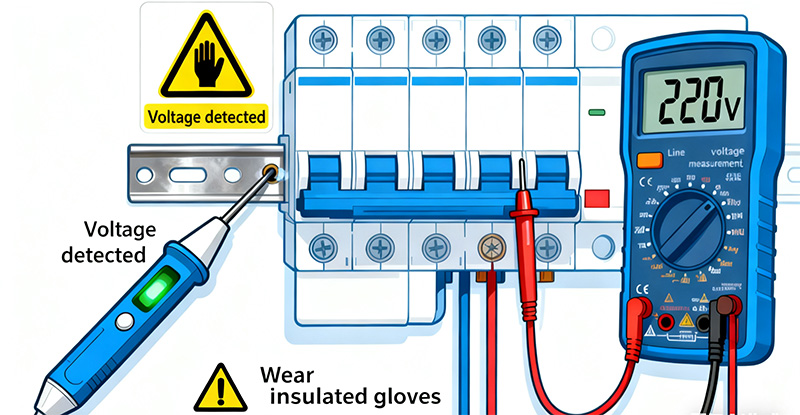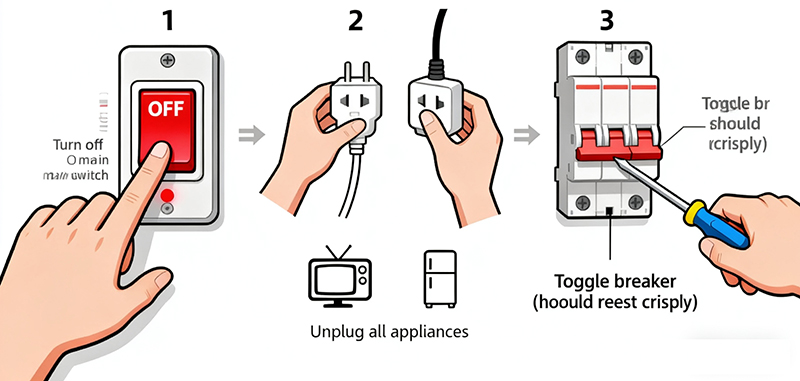Get quick appointment for technical support!
Comprehensive Guide to Testing Circuit Breakers
Sep 05,2025

Knowing how to test a breaker is useful for anyone working with electrical systems. Circuit breakers protect against overloads, short circuits, and fire risks. If a breaker keeps tripping, such as an electric circuit breaker, homeowners and professionals must find the cause and troubleshoot.
By learning safe testing methods—both with and without power—you can confirm breaker performance and address issues like what causes main breaker to trip. This guide outlines common breaker failures, testing approaches, and maintenance practices for reliable electrical safety.
How to Tell if a Circuit Breaker Is Broken
Common Warning Signs
Before testing, it’s important to recognize the signs that indicate a faulty breaker. If lights flicker, appliances shut off unexpectedly, or the breaker feels hot to the touch, these could all be warning signs. Additionally, if an MCB keeps tripping without an apparent reason, it may suggest the breaker itself is compromised.
Understanding Tripping Patterns
Recognising what it means when a breaker keeps tripping can help you distinguish between an electrical fault in the system and a breaker that has reached the end of its useful life. Breakers that frequently trip under normal load conditions may have internal wear or be undersized for the application.
Breaker Tripping with No Load
In some cases, a breaker may trip even when there is no noticeable electrical load. This phenomenon, often described as breaker tripping with no load, could mean internal wear, loose wiring connections, or a mechanical malfunction. These conditions highlight the need for closer inspection and, in many cases, replacement of the breaker.
What Could Cause a Breaker to Keep Tripping
Many people ask: What would cause a breaker to keep tripping repeatedly?
Several factors contribute to this:
- Overloaded circuits occur when too many devices draw power simultaneously.
- Short circuits are caused by faulty wiring or damaged insulation.
- Ground faults occur when current leaks to the ground through unintended paths.
- Ageing or defective breakers that can no longer handle rated loads.
Each of these issues emphasises why a breaker keeps tripping can’t be ignored. If a breaker repeatedly trips, understanding why MCB trip is important. Frequent tripping isn’t just inconvenient—it can signal serious underlying electrical hazards.
Why Test Circuit Breakers Without Power?
Safety Advantages
Testing without power is a key safety measure, preventing accidental shocks or electrical hazards. Live testing can be dangerous, especially for those without extensive electrical experience.
Diagnostic Benefits
Non-powered tests allow you to determine if a breaker is defective without energising the circuit. These tests are effective for spotting mechanical faults, resistance inconsistencies, or insulation issues safely.
When Non-Powered Testing Is Preferred
This approach is particularly useful in situations where powering the circuit could cause damage or when troubleshooting breakers in sensitive equipment. By using non-powered methods, you can diagnose issues without risking the safety of the system or the tester.
Essential Tools for Testing Without Power
Primary Tools
To effectively test breakers without power, having the right tools is crucial. A multimeter serves as the main instrument for diagnosing electrical issues, providing precise readings of continuity and resistance.
Supporting Tools
Additional tools like continuity testers, insulated screwdrivers, and resistance meters can enhance testing accuracy and allow for thorough inspections of breaker conditions.
Alternative Methods
Even without a multimeter, there are practical methods to check whether a breaker functions properly, including visual inspections and using basic continuity testers or swapping breakers for comparative testing. These approaches ensure testing is possible even with limited tools.
How to Test a Circuit Breaker With a Multimeter
A multimeter allows for a thorough assessment of breaker functionality. Begin by setting the multimeter to the resistance or continuity mode. Disconnect the breaker from the electrical panel and place the probes on the terminal and output contacts. A properly working breaker should show continuity when switched on and no continuity when switched off. If the readings are inconsistent, the breaker may be defective and require replacement.
Multimeter testing also helps confirm if the breaker responds properly under load simulation. If the electric circuit breaker keeps tripping, testing with a multimeter can rule out whether the issue lies in the wiring or the breaker itself.
How To Test a Circuit Breaker Without a Multimeter
Not every homeowner has access to a multimeter. In such cases, manual testing methods can help. By carefully removing the breaker and inspecting for physical damage, burn marks, or loose contacts, you can get initial clues. Testing with a continuity tester or even swapping the suspected breaker with a functioning one of the same type can help verify performance. These methods offer practical alternatives when professional tools are unavailable.
Advanced Testing Methods Without Power
Insulation Resistance Testing
For a more advanced approach, insulation resistance testing can be conducted using a megohmmeter. This process identifies hidden breakdowns within the breaker’s insulation, which might explain MCB tripping reasons or other electrical irregularities.
Torque and Connection Verification
Torque testing on the breaker terminals ensures connections remain tight and reliable, preventing loose contact from becoming a cause of breaker tripping with no load. Proper torque checks can also reveal mechanical weaknesses that may not be visible during standard inspections.
Additional Advanced Techniques
Other advanced methods include using specialised continuity testers, infrared thermography to detect hotspots, and monitoring breaker response under controlled simulated loads. These techniques provide a deeper understanding of breaker health without requiring live circuit power, helping prevent future failures and enhancing overall system reliability.
When to Replace a Circuit Breaker Based on Non-Powered Tests
Identifying Faulty Breakers
If non-powered testing reveals poor continuity, damaged insulation, or mechanical stiffness in the breaker switch, replacement is often the best solution. Frequent tripping, especially with no load, indicates the breaker cannot reliably perform its protective function.
Signs That Replacement Is Needed
Look for repeated trips without overload, unusual noises, or visible wear on the breaker components. These are clear indicators that the breaker may fail at any moment, posing safety risks.
Making the Decision
Understanding what causes the main breaker to trip repeatedly without an obvious overload helps determine whether replacement is necessary. Combining non-powered tests with careful inspection ensures informed decision-making, reducing the risk of electrical hazards and maintaining system reliability.
When to Call a Professional
While DIY testing can resolve many questions, persistent or complex breaker issues should be left to licensed electricians. If you are unsure why the MCB trips under normal conditions, or if your breaker trips with no load continues after basic testing, it is time to involve a professional. They have the tools and expertise to assess the electrical system thoroughly and provide long-term solutions.
Practical Benefits of Regular Circuit Breaker Testing
Improved Safety
Routine testing ensures both safety and efficiency. Breakers that function properly protect appliances from sudden surges and prevent electrical fires, reducing potential hazards in your home or workplace.
Cost and System Efficiency
Regular testing also helps extend the life of your electrical system, minimising costly repairs and avoiding unexpected downtime. By catching issues early, homeowners maintain a reliable power supply and system efficiency.
Proactive Risk Reduction
By staying proactive, homeowners reduce the risks associated with what could cause a breaker to keep tripping. Consistent testing ensures problems are detected early, enabling timely intervention and maintaining uninterrupted power supply.
Circuit Breaker Maintenance Best Practices
Effective maintenance involves more than just occasional testing. Regularly inspecting electrical panels, tightening connections, and replacing outdated breakers keeps the system reliable. Avoid overloading circuits by distributing appliances across multiple breakers.
Understanding why a breaker keeps tripping can help you adopt preventive practices such as upgrading wiring or installing additional circuits to balance electrical demand.
Conclusion
Learning how to test a breaker empowers both homeowners and professionals to address electrical issues confidently. Whether diagnosing MCB tripping reasons, identifying what it means when a breaker keeps tripping, or determining what causes the main breaker to trip, these methods provide clear insights into breaker performance.
By combining proper testing techniques, preventive maintenance, and professional guidance when necessary, you ensure a safe, efficient, and long-lasting electrical system.
--- END ---
